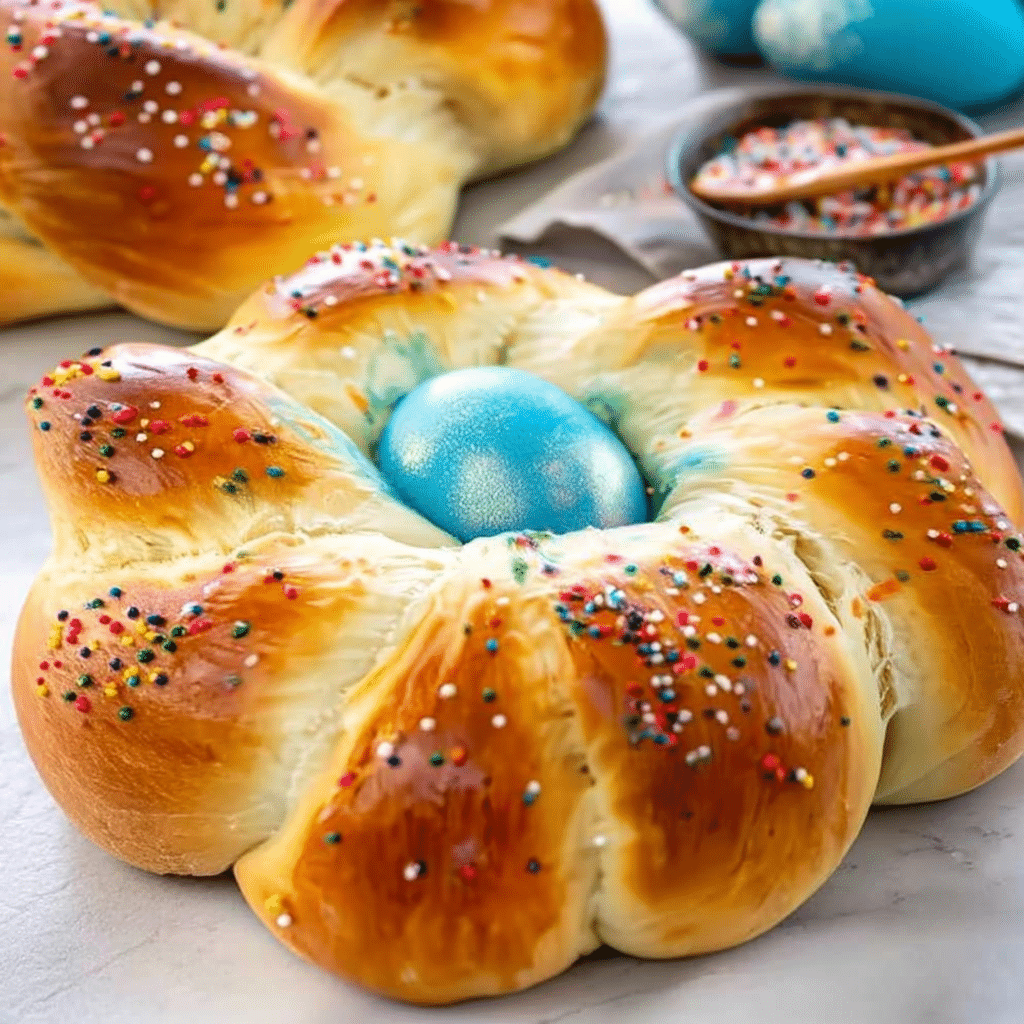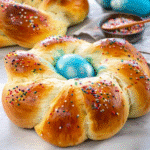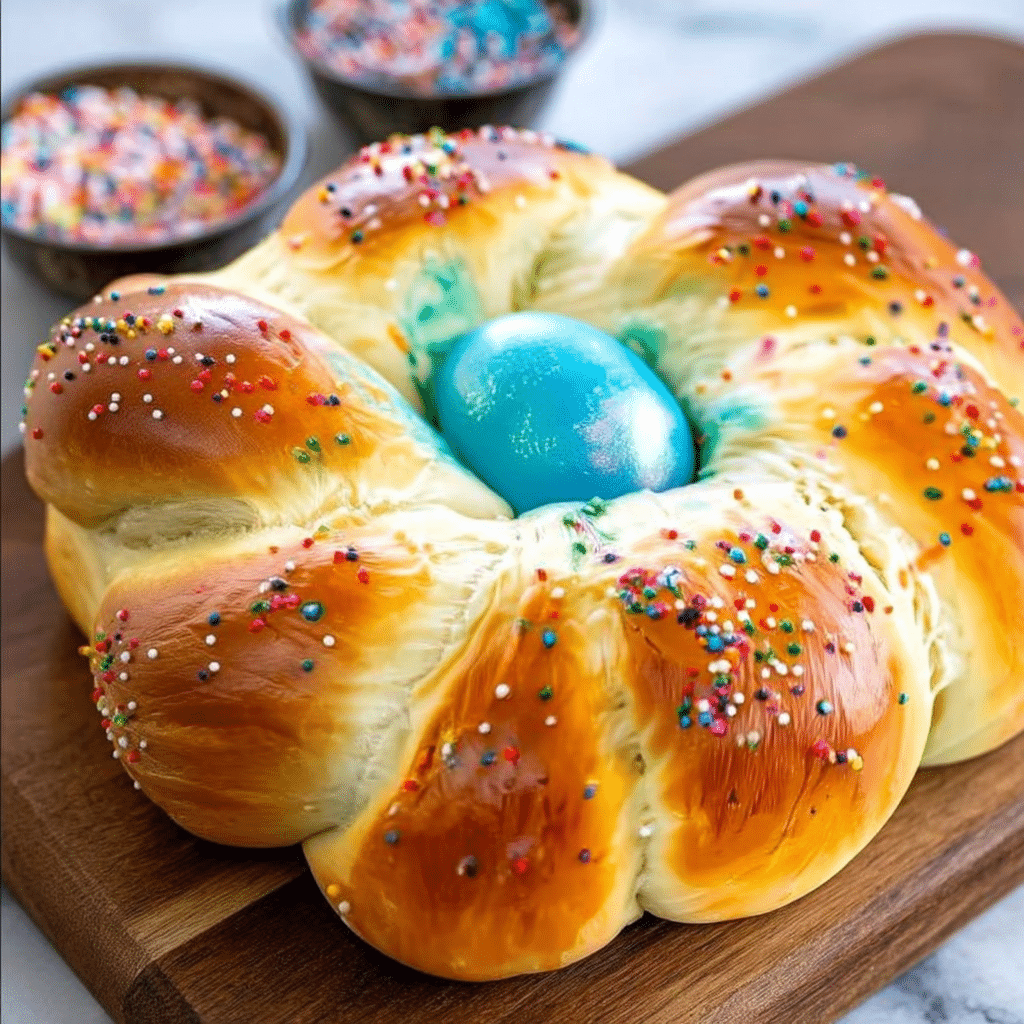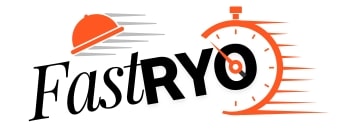For as long as I can remember, Easter in our Vermont kitchen was less about chocolate bunnies and more about the sweet scent of rising dough wafting through the house. That’s how I fell in love with Italian Easter Bread—a festive, braided sweet bread often crowned with brightly dyed eggs and cheerful sprinkles. This isn’t just bread; it’s a heartfelt tradition passed from one generation to the next.
In this article, I’ll walk you through the heritage, ingredients, step-by-step process, and creative spins on this beautiful bread. Whether you’re new to the kitchen or looking for a keto-friendly version, we’ll shape memories as much as dough. Let’s dig into the story and joy behind every braid.

Table of Contents
Italian Easter Bread – A Sweet, Braided Slice of Spring
What Is Italian Easter Bread?
Italian Easter Bread, known in Italy as pane di Pasqua, is a soft, sweet, yeast-risen bread braided and decorated with colorful eggs. Each slice carries tradition—somewhere between a dessert and a celebration centerpiece. This treat isn’t just for the taste buds—it’s for the soul, too.
While the recipe varies by region and family, the essence remains the same: flour, eggs, yeast, and a bit of joy. In Southern Italy, it’s often flavored with anise, while the Northern versions may lean on citrus zest for brightness.
Why It’s More Than Just Bread
When I first made this with my mom, I didn’t understand the symbolism. But over time, I realized every detail has meaning—the braided strands stand for unity and togetherness, and the eggs for rebirth. It’s no wonder this sweet bread has become an Easter favorite in Italian-American households.
From Sicilian celebrations to Midwestern brunch tables, this traditional Easter bread brings families together. Plus, it’s surprisingly fun to make—even with kids!
If you’re wondering how it fits into a modern low-carb lifestyle, don’t worry—we’ll explore that later, too.
Print
Italian Easter Bread: A Traditional Braided Delight with a Colorful Twist
- Total Time: 2 hours
- Yield: 1 large braided loaf 1x
- Diet: Vegetarian
Description
A soft, sweet Italian Easter Bread braided with colorful eggs, sprinkles, and light citrus flavor—perfect for spring brunch tables.
Ingredients
4 cups all-purpose flour
1/2 cup granulated sugar
1 tablespoon active dry yeast
1 cup warm whole milk (110°F)
3 large eggs
1/4 cup unsalted butter, softened
1 teaspoon anise extract or zest of 1 lemon
1 teaspoon salt
8–12 raw eggs, dyed
1 egg for egg wash
Rainbow sprinkles (optional)
Instructions
1. Bloom yeast in warm milk with sugar; let it foam for 5–10 minutes.
2. In a large bowl, mix flour, salt, zest or anise, eggs, butter, and yeast mixture.
3. Knead until smooth and elastic, about 7–10 minutes.
4. Let dough rise in a warm place for 1 to 1.5 hours until doubled.
5. Divide dough into three ropes, braid, and tuck dyed eggs inside the braids.
6. Form into a ring or oval and place on parchment-lined baking sheet.
7. Let rise again for 30–45 minutes.
8. Preheat oven to 350°F (175°C).
9. Brush with egg wash and top with sprinkles if using.
10. Bake for 30–35 minutes until golden brown.
11. Cool on a wire rack before slicing and serving.
Notes
Use unbleached flour for a rustic texture.
Substitute with almond and coconut flour for a keto-friendly version.
For natural egg dye, try beet juice or turmeric.
Hard-boiled eggs can be added after baking if preferred.
- Prep Time: 25 minutes
- Cook Time: 35 minutes
- Category: Bread
- Method: Baking
- Cuisine: Italian
Nutrition
- Serving Size: 1 slice
- Calories: 210
- Sugar: 6g
- Sodium: 190mg
- Fat: 7g
- Saturated Fat: 3g
- Unsaturated Fat: 3g
- Trans Fat: 0g
- Carbohydrates: 31g
- Fiber: 1g
- Protein: 6g
- Cholesterol: 65mg
Keywords: Italian Easter Bread, sweet Easter bread, braided bread with eggs
The Story Behind the Tradition
The Symbolism of Italian Easter Bread
Italian Easter Bread isn’t just a holiday treat—it’s a spiritual expression baked with meaning. Every piece of this soft, braided loaf tells a deeper story, going far beyond sugar and flour. At its core, this sweet Easter bread symbolizes rebirth, unity, and celebration.
Let’s start with the eggs. Traditionally dyed in bright spring colors and gently nestled into the braids, they represent new life and resurrection. They’re a reminder that spring is here, and with it, renewal.
The braided strands? They’re not just pretty—they speak to family unity and togetherness. Some families braid three strands to represent the Holy Trinity, while others see it as past, present, and future woven together.
A Multigenerational Ritual
When I was little, I’d sit on the counter while my mom braided the dough. Her hands moved with such rhythm and care—it felt like watching magic. She told me how her mother taught her in the same way, with the same warm kitchen smells and quiet joy.
Even though Mom’s no longer with me, I still follow her ritual each Easter. I dye the eggs, heat the oven, and braid the dough just like she did. Now, it’s not just a recipe—it’s a legacy.
Ingredients with Purpose
Key Ingredients in Traditional Italian Easter Bread
One of the most heartwarming things about Italian Easter Bread is how it combines simple, meaningful ingredients to create something truly celebratory. Whether you’ve made it for years or this is your first time, you’ll appreciate how each component carries both flavor and symbolism.
In my home kitchen here in Vermont, I love leaning on real, wholesome ingredients—just like my mom did. And because many readers at Fastryo.com are exploring keto or low-carb lifestyles, I’ve included a few light swap suggestions too.
Flour, Eggs, and Yeast – A Trio of Life
Every Italian Easter Bread recipe begins with a base of flour, eggs, and yeast. Together, they represent growth, life, and transformation—a beautiful metaphor for the season of spring and renewal.
I usually use unbleached all-purpose flour, farm-fresh eggs, and active dry yeast for that classic soft, pillowy texture.
Keto swap: A combo of almond flour, psyllium husk, and baking powder can give a decent structure in a low-carb version, even if the rise is more subtle.
Anise or Lemon Zest – Flavor of Heritage
This bread’s old-world charm often comes from a whisper of anise or fresh lemon zest. That aromatic touch is more than just flavor—it’s memory. I still remember zesting lemons beside my mom, watching the sunshine catch each curl.
Either flavor infuses the dough with brightness and authenticity. You can even blend the two for a citrus-spice twist.
Naturally, these ingredients work great in both traditional and low-carb Italian Easter Bread variations.
Colorful Eggs – A Joyful Centerpiece
Tucked inside each braid are pastel-colored raw eggs, which bake in place and emerge as bright, edible decorations. They represent rebirth and are part of what makes Italian Easter Bread so instantly recognizable.
Personally, I love dyeing the eggs with natural colors—beet juice for pinks, red cabbage for blue. It’s a fun way to involve kids, too.
Note for keto bakers: You can press in hard-boiled eggs after baking to keep things friendly for low-carb diets.
Sprinkles – Playful, Festive Charm
The finishing touch? A generous handful of rainbow sprinkles. They make Italian Easter Bread look like a celebration on a plate—perfect for brunch, church gatherings, or gifting to neighbors.
Brush on a light egg wash first to help them stick, and if you’re watching sugar, try using dye-free or keto-approved sprinkles that still dazzle without compromise.
How to Make Italian Easter Bread at Home
If you’ve been dreaming of baking that iconic Italian Easter Bread yourself, you’re in the right place. I’ll guide you through every step—from mixing the dough to the final golden glaze. Plus, I’ll share some keto-friendly swaps for those who want to enjoy the tradition without the carbs.

Let’s get baking!
Ingredients List (Classic and Keto-Friendly Options)
- 4 cups all-purpose flour (or 3 cups almond flour + 1 cup coconut flour for keto)
- 1/2 cup granulated sugar (or erythritol for keto)
- 1 tablespoon active dry yeast
- 1 cup warm whole milk (about 110°F) (or unsweetened almond milk)
- 3 large eggs + 1 egg for egg wash
- 1/4 cup unsalted butter, softened (or coconut oil)
- 1 teaspoon anise extract or 1 tablespoon anise seeds (optional)
- Zest of 1 lemon
- 1 teaspoon salt
- 8 to 12 whole raw eggs, dyed for decoration (or hard-boiled eggs for keto version)
- Rainbow sprinkles (sugar-free sprinkles for keto)
Directions
1. Bloom the Yeast
Start by warming your milk to about 110°F—not too hot, not too cold. Stir in the sugar and yeast, then let it sit for about 5 to 10 minutes until it becomes foamy. This means your yeast is alive and kicking!
2. Prepare the Dough
In a large mixing bowl, combine the flour, salt, lemon zest, and anise (if using). Add the eggs, softened butter, and the foamy yeast mixture. Mix until a sticky dough forms.
If you have a stand mixer, use the dough hook on medium speed for 5 to 7 minutes. Otherwise, grab your hands and knead the dough on a floured surface for about 10 minutes until smooth and elastic.
3. Let It Rise
Place the dough in a lightly oiled bowl, cover with a warm, damp towel or plastic wrap, and set it in a warm spot to rise for about 1 to 1.5 hours—until it doubles in size.
Pro tip from my Vermont kitchen: If it’s chilly, place the bowl near a sunny window or inside an oven with the light on. Cold proofing slows yeast activity, so patience is key!
4. Shape the Braids
Punch down the dough gently and divide it into three equal parts. Roll each into long ropes about 12 inches long.
Braid the three ropes together, tucking colorful raw eggs into the dough’s folds as you go—about every 4 inches. Once braided, form the dough into a circle or oval on a baking sheet lined with parchment paper.
5. Add Colored Eggs
Place the dyed eggs snugly into the dough. They’ll bake in place, turning a beautiful glossy color. If you’re making a keto version, skip the raw eggs in the braid and instead place boiled, dyed eggs around the baked bread.
6. Final Proof & Bake
Cover the braided loaf loosely with plastic wrap or a towel, and let it rise again for 30 to 45 minutes until puffy.
Preheat your oven to 350°F (175°C). Brush the loaf gently with a beaten egg wash to get that shiny, golden crust.
Bake for 30 to 35 minutes, or until the bread is golden brown and sounds hollow when tapped on the bottom.
7. Glaze & Decorate
Once out of the oven, brush the loaf lightly with a simple sugar glaze made from powdered sugar and lemon juice (optional). Sprinkle with rainbow sprinkles immediately for that classic festive look.
Let the bread cool on a wire rack before slicing—if you can wait that long!
Tips for Perfect Texture and Rise
- Warm Towel Method: Keeping the dough covered with a warm, damp towel during rising helps maintain moisture and encourages yeast activity. I learned this from my mom’s kitchen, especially useful in Vermont’s cool spring.
- Proofing in Cold Weather: If your kitchen is chilly, create a warm spot by placing the dough bowl inside your oven with just the light turned on. It’s a gentle way to coax the yeast without overheating.
- Don’t Overknead: Knead until the dough is smooth but still soft and pliable. Overworking can make it tough.
- Egg Wash: Brush the dough with egg wash just before baking for a beautiful golden crust that also helps sprinkles stick.
Make It Your Own – Variations to Try
One of the best things about Italian Easter Bread is how wonderfully adaptable this traditional treat can be. Whether you’re baking Italian Easter Bread for the first time or have made it for years, customizing the flavors and shapes can add a fresh twist to your festive table. Here are some tasty ways to make Italian Easter Bread uniquely yours.
Orange or Almond Flavor
For a bright, zesty take on classic Italian Easter Bread, try swapping or mixing the usual lemon zest with fresh orange zest. This citrus addition lifts the flavor, giving the bread a sunny, springtime vibe that’s hard to resist. Another beloved flavor twist is a splash of almond extract, which adds a rich, nutty aroma and complements the soft, sweet dough perfectly. Both orange and almond flavors bring a new dimension to your Italian Easter Bread, making it a crowd-pleaser.
Mini Individual Braids
If you’re aiming for charm and convenience, mini versions of Italian Easter Bread are a fantastic option. Making mini individual braided loaves means you get perfectly portioned, festive breads that are great for sharing at brunch or gifting to friends and family. Each mini braid can cradle one or two colorful eggs, maintaining the traditional look and feel of Italian Easter Bread while offering personal-sized servings.
Keto or Gluten-Free Adaptations
At Fastryo, we love adapting traditional recipes like Italian Easter Bread for those following keto, low-carb, or gluten-free diets. You can swap wheat flour with almond flour or coconut flour to make a delicious, low-carb version of Italian Easter Bread. Since keto dough doesn’t rise exactly like the classic yeast dough, adding baking powder and psyllium husk helps improve texture. Instead of baking raw eggs into the loaf, decorate with hard-boiled, dyed eggs after baking to keep the bread keto-friendly and festive.
How to Serve Italian Easter Bread
Serving Italian Easter Bread is as joyful as baking it. This sweet, braided loaf shines brightest as the centerpiece of your Easter brunch table. Imagine it sitting proudly alongside fresh flowers and pastel decorations—inviting everyone to break off a soft, fragrant slice.
One of my favorite ways to enjoy Italian Easter Bread—what I call my “Ryo-style”—is simply toasted with a pat of butter and a steaming cup of coffee. The crust crisps just right, and the inside stays tender and slightly sweet. It’s the perfect little moment of comfort amid the holiday buzz.
Storing & Freezing Italian Easter Bread
To keep your Italian Easter Bread fresh, wrap it tightly in plastic wrap or place it in an airtight container at room temperature. It stays soft for up to three days this way.
If you want to freeze it, slice the bread first and wrap individual pieces in foil or freezer bags. When you’re ready to enjoy, reheat slices gently in a toaster or oven at low temperature—this keeps the bread moist without drying it out.
Whether fresh or reheated, Italian Easter Bread tastes best when shared with loved ones, warm and full of tradition.
What to Serve With Italian Easter Bread
Classic Italian Combinations
Italian Easter Bread pairs beautifully with traditional Italian favorites. Serve slices alongside thin ribbons of prosciutto, a selection of creamy cheeses like fresh mozzarella or pecorino, and a rich, dark espresso to balance the sweetness. This classic trio brings out the bread’s delicate flavors while honoring its heritage.
Modern American Twists
For a fresh, contemporary take, try serving your Italian Easter Bread with savory spreads like avocado mash or tangy egg salad. These combos add a satisfying creaminess and make your Easter brunch feel both comforting and current. Whether you prefer the old-world charm or a new-school spin, Italian Easter Bread adapts beautifully to your table.
Why This Bread Still Matters
Easter is more than a holiday—it’s a time for connection, renewal, and celebration. For me, Italian Easter Bread carries the warmth of family stories, the joy of shared traditions, and the comfort of a kitchen filled with love. Baking this bread is like weaving those moments into dough, where every braid tells a story.
Whether you’re baking in a busy kitchen or passing down recipes to little ones, this bread reminds us that food isn’t just fuel—it’s a way to hold on to what truly matters: family, heritage, and heart.
Ready to Bake and Share the Joy?
Now it’s your turn to bring Italian Easter Bread to life in your own kitchen. Whether you follow the classic recipe or try a keto-friendly twist, this sweet Easter bread is sure to brighten your holiday table.
If you bake it, share your photos and stories—tag @Fastryo so we can celebrate together!
With love from Ryo’s kitchen — follow Fastryo on Facebook and let me know what you think!
Italian Easter Bread – FAQs
What is the meaning behind the colored eggs?
The colorful eggs baked into Italian Easter Bread are symbols of rebirth and new life, perfectly fitting the spirit of Easter and spring. Nestled inside the braided bread, these eggs transform the loaf into a festive centerpiece full of meaning.
Can I make Italian Easter Bread without a stand mixer?
Absolutely! While a stand mixer makes kneading easier, you can hand-knead the dough on a floured surface for about 10 minutes until smooth and elastic. It’s a bit more work but very satisfying—plus, you get to connect with the dough just like traditional bakers.
Can I make Italian Easter Bread ahead of time?
Yes, you can prepare the dough and let it rise overnight in the fridge for deeper flavor. The braided loaf can be baked the next day or even frozen after baking. Just reheat gently before serving to enjoy that fresh, soft texture.
How is Italian Easter Bread different from other sweet breads?
Unlike many sweet breads, Italian Easter Bread is unique as a braided bread with eggs baked right inside. It combines a tender, slightly sweet dough with symbolic decorations, making it both a tasty treat and a meaningful holiday tradition.
Is there a keto version of Italian Easter Bread?
Yes! Many home cooks adapt the classic recipe using low-carb flours like almond or coconut flour and skip baking raw eggs inside. Instead, decorated hard-boiled eggs are placed around the loaf after baking, keeping the festive spirit alive while fitting a keto lifestyle.
